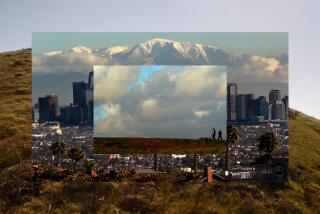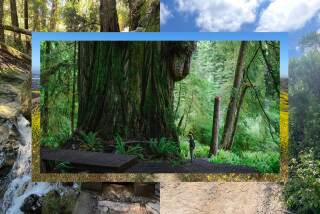MOUNTAIN BIKES
As a teen-ager, he rode down the brush-bordered trails and up the winding fire roads on a motorcycle. Every day, Anthony Joseph would come home from school, toss his books into his room, grab his motorcycle helmet and head for the hills on his Yamaha.
Homework could wait. There were hills to climb.
A decade later, Joseph knocks off from work, tosses his briefcase onto his sofa, grabs his helmet and heads for the same hills in the Santa Monica Mountains--on his bicycle. Home work still waits.
Joseph’s bike, a mountain bike, is an 18-gear factory-built cross between a conventional 10-speed and a dirt motorcycle. The difference from a motorcycle is obvious; it takes a closer look to distinguish a mountain bike from a conventional 10-speed, or road bike. Mountain bikes have motocross-style handle bars, 15-18 speeds, 2-inch wide knobby tires and a sturdy frame.
“Everything about the thing is heavy duty,” Joseph said. “You can throw it across the street and nothing would happen to it.”
When thrown from the bike, however, something nasty happens to the cyclist. Joseph recently found a trail south of Mulholland Drive, just east of Coldwater Canyon Boulevard in the hills above North Hollywood. As he descended the trail, a magnificent view of the San Fernando Valley before him, he spotted a bump.
“You have to either slow down and roll over it, or speed up and jump,” said Joseph, who couldn’t make up his mind.
When he hit the bump, his bike lunged forward, flying nearly five feet above the ground. His body flew nearly seven feet above the ground--in another direction. As a result of an ugly landing, Joseph now sports three ugly abrasions. One on his upper hip, one on his side and one on his shoulder.
“I should have slowed down,” Joseph said, and then, in mock excitement, added, “But this is why I do it. The thrills, the chills, the spills.”
His scrapes were a painful price to pay for the thrills, but hardly the most expensive.
Store-bought cycles are priced as high as $2,000--or $1,000 less than Joseph paid for his motorcycle 12 years ago.
“It’s worth it,” said Jeff Redman, 31, a Reseda resident and an avid mountain cyclist. “If you don’t have the right equipment, how do you expect to be any good at anything?”
The price hasn’t slowed the demand for the mountain bikes. Bill DeBor of the Pedal Shop in North Hollywood estimates that half of the cyclists in Southern California are now riding mountain bikes.
“Fifty to 65% of our sales are now mountain bikes,” DeBor said. “This time last year, they were just coming into vogue. Since then, sales have doubled--almost tripled.
“It’s getting bigger.”
Big enough to have spawned competitions, clubs and magazines.
An estimated 15 million bicycles were sold in the United States last year; 40% were mountain bikes.
Larry Hoffman, owner of the Pedal Shop and a follower of mountain biking, said the sport is about to peak.
“It appeals to people who are just getting into biking,” Hoffman said. “It also appeals to the cyclist who wants to get rid of his 10-speed and get something more comfortable. A person who has never owned a bike and wants to get into cycling, will, more times than not, buy a mountain bike.”
Hoffman said there is an organization that sanctions mountain bike races and functions--the National Off Road Bike Assn. Competition also is gaining popularity.
Joseph, 28, who used to ride his motorcycle through the hills above Studio City and now owns a Beverly Hills real estate firm, said his new hobby is a way to get away from traffic and civilization.
“I used to road race,” Joseph said. “But it’s different up here. I used to ride motocross all the time. This way, I get the best of both worlds. I like to hike and I missed riding in the dirt. Up here, there aren’t any cars to compete with.”
The competition, oddly, comes from hikers, Redman said.
“It’s too bad that cyclists and hikers can’t get along better,” he said. “The bikes make no sound and they do nothing to hurt the land. But still, some places have been closed to mountain bikes.”
Earlier this year, the state adopted a policy that restricts mountain bikes to fire roads, unless otherwise posted, and restricts hikers to trails, unless otherwise posted.
John Schmill, a ranger at Malibu Creek State Park, said that incidents between hikers and bikers and between bikers and horseback riders have occurred, but are rare because the park has enough space for everybody.
Schmill said he is seeing more and more mountain bike riders at his park--more than two dozen on a good weekend--and believes both hikers and bikers can use the park without problems.
“On extremely hot days,” Schmill said, “There are no problems whatsoever. You’d have to be crazy to come out here on a bike. You’d get about half a mile before you passed out.”
Schmill said that some cyclists do ride in hot weather and that he has never seen anyone pass out. But where the sun hasn’t stopped cyclists, bureaucracy has.
In Pasadena a recent problem between horse riders and mountain cyclists led the county to close Eaton Canyon Park to cyclists. Since then, the state has initiated a study on mountain bike riding, hopeful of providing safe and accessible riding areas.
Chief Gordon Pearson, a community relations officer for the L.A. County Fire Dept., said his department encourages use of public land for riding. He added that cyclists may use any public road or trail that isn’t restricted by the city or county. Signs are normally posted on restricted roads and the use of such a road is considered trespassing. Pearson stressed that smoking and open fires are forbidden.
“There are trails that may look like fire roads or fire breaks,” Pearson said. “The public may use them if there are no signs posted. But, if a person goes around a gate, or over a fence--whether on a public or private road--it’s trespassing.”
The Los Angeles City Parks and Recreation Dept. has no areas designated specifically for mountain bikes. Most city and county officials contacted by The Times knew of mountain bikes but few were aware of their popularity. One spokesman for the county said that as popularity increases, so will riding areas.
And that’s fine with Joseph, who rides his mountain bike about four times a week. “I think a lot of people are more in tune with the outdoors and fitness,” he said. “Bicycling itself is a very popular sport.”
DeBor, who said he doesn’t own a mountain bike but rides a road bike to work each day, believes mountain bikes have another appeal.
“They’re more comfortable than road bikes,” DeBor said. “These guys are just getting back into riding. Many of the riders grew up riding cruisers, a bike where you sit straight up. And then, maybe when they were in college, they rode a 10-speed. Well, with a mountain bike, you’re sitting straight up, not bent over holding the handle bars. Their comfort alone is appealing.”
But their susceptibility to accidents is not, and when bikers hit the road, the road hits back.
Redman said the thought of injury has to be put aside while riding mountain bikes.
“You’re not winning,” he said, “unless you have confirmed convictions and you ride with reckless abandon.”
More to Read
Sign up for The Wild
We’ll help you find the best places to hike, bike and run, as well as the perfect silent spots for meditation and yoga.
You may occasionally receive promotional content from the Los Angeles Times.






